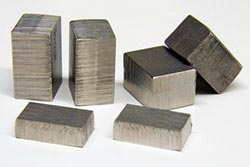Materials that shrink when heated

Samples of Invar. Also known as FeNi36, it is an iron-nickel alloy notable for its lack of expansion or contraction with temperature changes. Copyright : Public Domain<br>
One common reason that people with fillings experience toothache is that their fillings expand at a different rate to the original tooth when, for example, drinking a hot drink. Contrary to intuition, however, not all materials expand when heated—some actually contract. Recent research on these so-called negative thermal expansion (NTE) materials has led to the discovery of alloys exhibiting unexpectedly large thermal contraction.
Controlling the thermal expansion of composites is important for producing nanometer-scale electronic circuits, as well as the next-generation fuel cells and thermoelectric devices. An ability to combine NTE materials with ‘normal’ materials which expand upon heating ensures a reduction in thermal expansion in a composite material – something that people with tooth fillings would appreciate. An example of such a composite is Invar, an iron-nickel alloy with a uniquely low coefficient of thermal expansion. As a result it is used where high dimensional stability is required, such as precision instruments, clocks or seismic creep gauges.
Koshi Takenaka at the Department of Crystalline Materials Science, Nagoya University in Japan works on NTE materials for practical applications. In the latest issue of Science and Technology of Advanced Materials (link below) he summarizes the physical mechanisms governing NTE with emphasis on recent developments.
Takenaka notes that, “NTE materials will expand our capability of thermal-expansion control, opening a new paradigm of materials science and technology thermal-expansion-adjustable composites”. One challenge facing the scientist is that the addition of NTE materials to composites leads to undesirable instabilities at interfaces. New methods for producing stable interfaces between the host composite and NTE compensators are of critical importance. Nevertheless, the so-called ‘one-component’ materials—such as manganese antiperovskites, zirconium vanadates, and hafnium tungstates—exhibiting negligible thermal expansion offer a promising route towards achieving this goal.
Related information
[1] ‘Negative thermal expansion materials: Technological key for control of thermal expansion’ by Koshi Takenaka, Science and Technology of Advanced Materials Vol. 13 (2012) 013001. http://iopscience.iop.org/1468-6996/13/1/013001
Affiliation: Department of Crystalline Materials Science, Nagoya University, Nagoya 464-8603, Japan
Media contacts:
Mikiko Tanifuji
National Institute for Materials Science, Tsukuba, Japan
Email: stam_office@nims.go.jp
Tel. +81-(0)29-859-2494
Media Contact
More Information:
http://www.nims.go.jpAll latest news from the category: Materials Sciences
Materials management deals with the research, development, manufacturing and processing of raw and industrial materials. Key aspects here are biological and medical issues, which play an increasingly important role in this field.
innovations-report offers in-depth articles related to the development and application of materials and the structure and properties of new materials.
Newest articles

Bringing bio-inspired robots to life
Nebraska researcher Eric Markvicka gets NSF CAREER Award to pursue manufacture of novel materials for soft robotics and stretchable electronics. Engineers are increasingly eager to develop robots that mimic the…

Bella moths use poison to attract mates
Scientists are closer to finding out how. Pyrrolizidine alkaloids are as bitter and toxic as they are hard to pronounce. They’re produced by several different types of plants and are…

AI tool creates ‘synthetic’ images of cells
…for enhanced microscopy analysis. Observing individual cells through microscopes can reveal a range of important cell biological phenomena that frequently play a role in human diseases, but the process of…





















